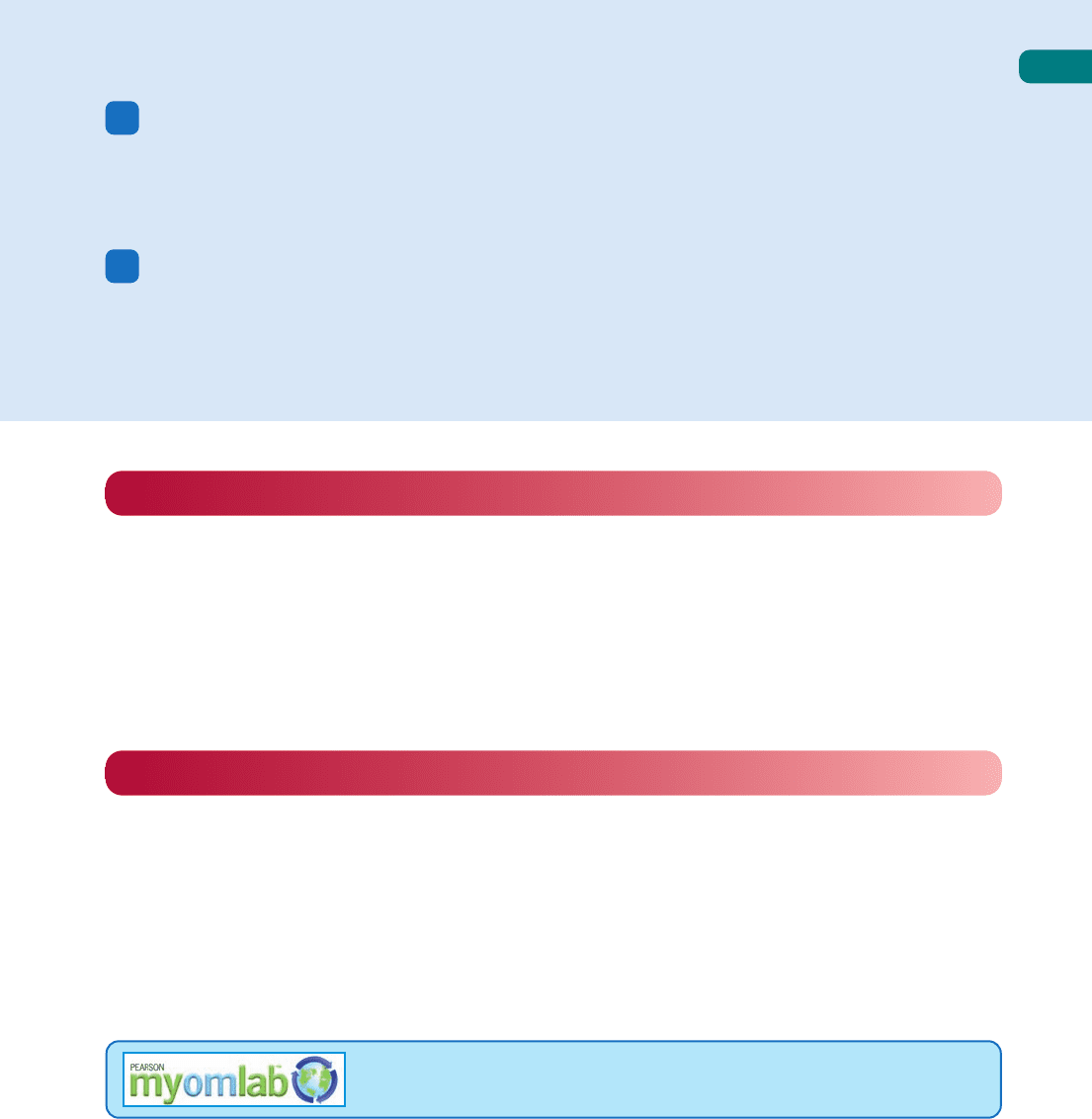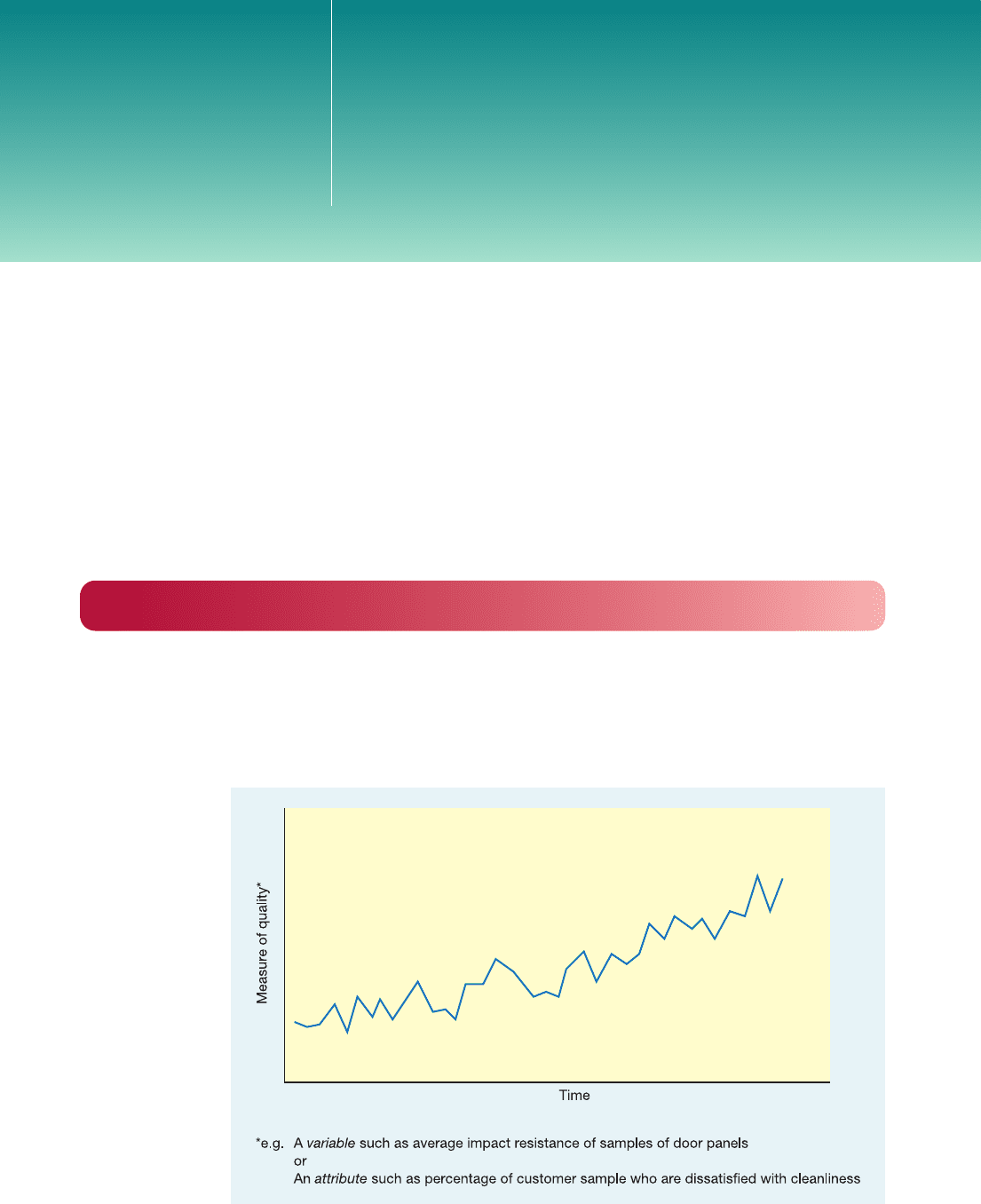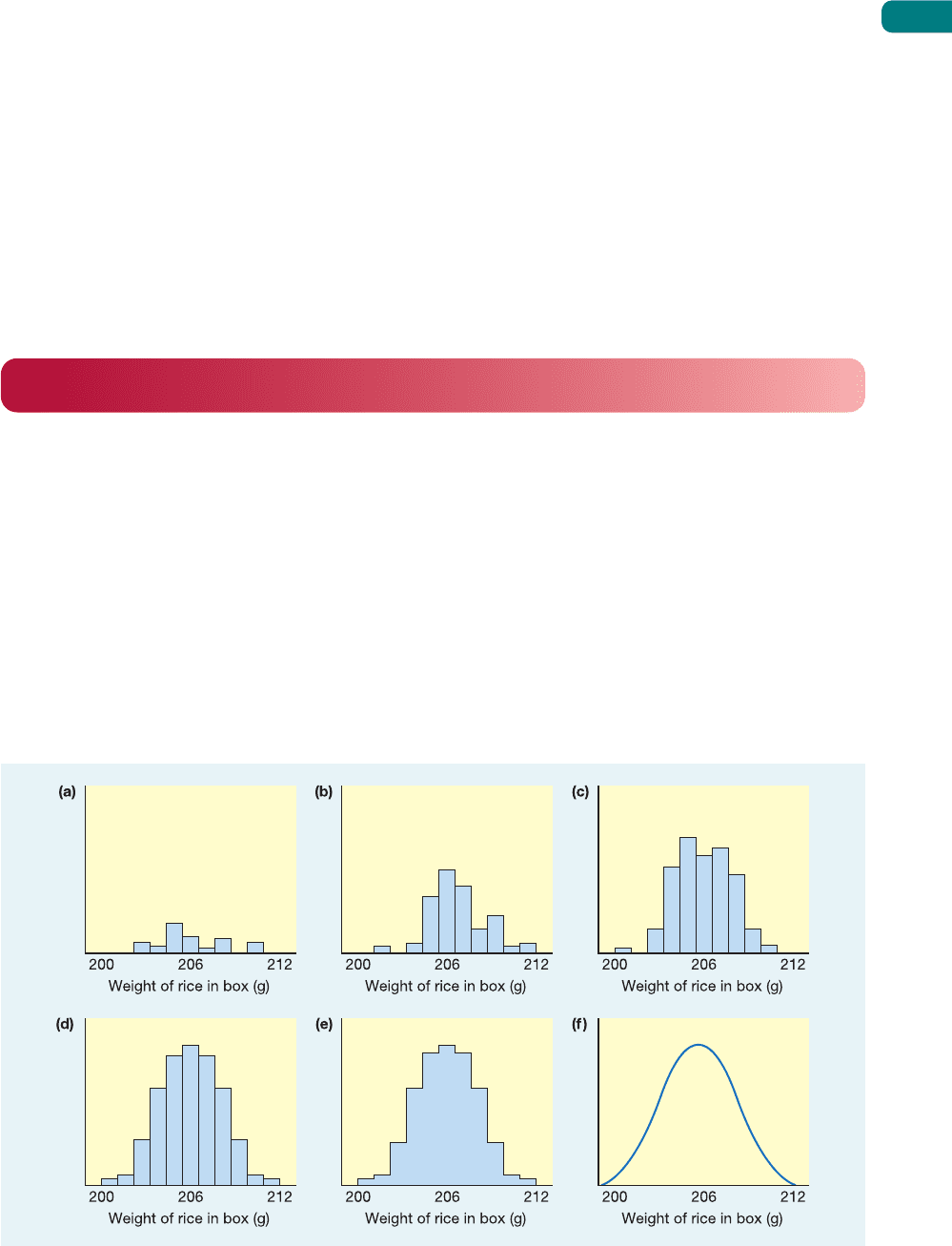Nigel S., Chambers S., Johnson R. Operations Management
Подождите немного. Документ загружается.


not deteriorate. Its purpose when it was first framed was to provide an assurance to the pur-
chasers of products or services that they have been produced in such a way that they meet
their requirements. The best way to do this, it was argued, was to define the procedures,
standards and characteristics of the management control system which governs the operation.
Such a system would help to ensure that quality was ‘built into’ the operation’s transformation
processes.
In 2000 ISO 9000 was substantially revised. Rather than using different standards for
different functions within a business it took a ‘process’ approach that focused on outputs
from any operation’s process rather than the detailed procedures that had dominated the pre-
vious version of ISO 9000. This process orientation requires operations to define and record
core processes and sub-processes (in a manner very similar to the ‘hierarchy of processes’
principle that was outlined in Chapter 1). In addition, processes are documented using the
process mapping approach that was described in Chapter 4. Also, ISO 9000 (2000) stresses
four other principles.
● Quality management should be customer-focused. Customer satisfaction should be measured
through surveys and focus groups and improvement against customer standards should
be documented.
● Quality performance should be measured. In particular, measures should relate both to
processes that create products and services and customer satisfaction with those products
and services. Furthermore, measured data should be analysed in order to understand
processes.
● Quality management should be improvement-driven. Improvement must be demonstrated
in both process performance and customer satisfaction.
● Top management must demonstrate their commitment to maintaining and continually
improving management systems. This commitment should include communicating the
importance of meeting customer and other requirements, establishing a quality policy
and quality objectives, conducting management reviews to ensure the adherence to qual-
ity policies, and ensuring the availability of the necessary resources to maintain quality
systems.
ISO 9000 is seen as providing benefits both to the organizations adopting it (because it
gives them detailed guidance on how to design their control procedures) and especially to
customers (who have the assurance of knowing that the products and services they purchase
are produced by an operation working to a defined standard). It may also provide a useful
discipline to stick to ‘sensible’ process-oriented procedures which lead to error reduction,
reduced customer complaints and reduced costs of quality, and may even identify existing
procedures which are not necessary and can be eliminated. Moreover, gaining the certificate
demonstrates that the company takes quality seriously; it therefore has a marketing benefit.
Part Three Planning and control
514
Notwithstanding its widespread adoption (and its revision to take into account some of its
perceived failings), ISO 9000 is not seen as beneficial by all authorities, and is still subject
to some specific criticisms. These include the following:
● The continued use of standards and procedures encourages ‘management by manual’
and over-systematized decision-making.
● The whole process of documenting processes, writing procedures, training staff and
conducting internal audits is expensive and time-consuming.
● Similarly, the time and cost of achieving and maintaining ISO 9000 registration are
excessive.
● It is too formulaic. It encourages operations to substitute a ‘recipe’ for a more customized
and creative approach to managing operations improvement.
Critical commentary
M17A_SLAC0460_06_SE_C17A.QXD 10/20/09 9:51 Page 514

Chapter 17 Quality management
515
Summary answers to key questions
Check and improve your understanding of this chapter using self assessment questions
and a personalised study plan, audio and video downloads, and an eBook – all at
www.myomlab.com.
➤ What is quality and why is it so important?
■ The definition of quality used in this book defines quality as ‘consistent conformance to cus-
tomers’ expectations’.
➤ How can quality problems be diagnosed?
■ At a broad level, quality is best modelled as the gap between customers’ expectations con-
cerning the product or service and their perceptions concerning the product or service.
■ Modelling quality this way will allow the development of a diagnostic tool which is based around
the perception–expectation gap. Such a gap may be explained by four other gaps:
– the gap between a customer’s specification and the operation’s specification;
– the gap between the product or service concept and the way the organization has specified it;
– the gap between the way quality has been specified and the actual delivered quality;
– the gap between the actual delivered quality and the way the product or service has been
described to the customer.
➤ What steps lead towards conformance to specification?
■ There are six steps:
– define quality characteristics;
– decide how to measure each of the quality characteristics;
– set quality standards for each characteristic;
– control quality against these standards;
– find and correct the causes of poor quality;
– continue to make improvements.
■ Most quality planning and control involves sampling the operations performance in some way.
Sampling can give rise to erroneous judgements which are classed as either type I or type II
errors. Type I errors involve making corrections where none are needed. Type II errors involve
not making corrections where they are in fact needed.
➤ What is total quality management ( TQM)?
■ TQM is ‘an effective system for integrating the quality development, quality maintenance and
quality improvement efforts of the various groups in an organization so as to enable produc-
tion and service at the most economical levels which allow for full customer satisfaction’.
■ It is best thought of as a philosophy that stresses the ‘total’ of TQM and puts quality at the
heart of everything that is done by an operation.
■ ‘Total’ in TQM means the following:
– meeting the needs and expectations of customers;
– covering all parts of the organization;
– including every person in the organization;
– examining all costs which are related to quality, and getting things ‘right first time’;
– developing the systems and procedures which support quality and improvement;
– developing a continuous process of improvement.
M17A_SLAC0460_06_SE_C17A.QXD 10/20/09 9:51 Page 515

Part Three Planning and control
516
‘Before the crisis the quality department was just
for looks, we certainly weren’t used much for
problem solving, the most we did was inspection.
Data from the quality department was brought to
the production meeting and they would all look
at it, but no one was looking behind it’ (Quality
Manager, Preston Plant).
The Preston plant of Rendall Graphics was
located in Preston, Vancouver, across the con-
tinent from their headquarters in Massachusetts.
The plant had been bought from the Georgetown
Corporation by Rendall in March 2000. Precision
coated papers for ink-jet printers accounted
for the majority of the plant’s output, especially
paper for specialist uses. The plant used coating
machines that allowed precise coatings to be
applied. After coating, the conversion department cut the
coated rolls to the final size and packed the sheets in small
cartons.
The curl problem
In late 1998 Hewlett-Packard (HP), the plant’s main customer
for ink-jet paper, informed the plant of some problems it
had encountered with paper curling under conditions of low
humidity. There had been no customer complaints to HP,
but their own personnel had noticed the problem, and they
wanted it fixed. Over the next seven or eight months a team
at the plant tried to solve the problem. Finally, in October
of 1999 the team made recommendations for a revised
and considerably improved coating formulation. By January
2000 the process was producing acceptably. However, 1999
had not been a good year for the plant. Although sales were
reasonably buoyant the plant was making a loss of around
$2 million for the year. In October 1999, Tom Branton,
previously accountant for the business, was appointed as
Managing Director.
Slipping out of control
In the spring of 2000, productivity, scrap and re-work
levels continued to be poor. In response to this the opera-
tions management team increased the speed of the line
and made a number of changes to operating practice in
order to raise productivity.
‘Looking back, changes were made without any proper
discipline, and there was no real concept of control. We
were always meeting specification, yet we didn’t fully
understand how close we really were to not being able to
make it. The culture here said, “If it’s within specification
then it’s OK” and we were very diligent in making sure
that the product which was shipped was in specification.
However, Hewlett-Packard gets “process charts” that
Case study
Turnround at the Preston plant
enable them to see more or less exactly what is happening
right inside your operation. We were also getting all the
reports but none of them were being internalized, we were
using them just to satisfy the customer. By contrast, HP
have a statistically-based analytical mentality that says to
itself, “You might be capable of making this product but
we are thinking two or three product generations forward
and asking ourselves, will you have the capability then, and
do we want to invest in this relationship for the future?” ’
(Tom Branton)
The spring of 2000 also saw two significant events.
First, Hewlett-Packard asked the plant to bid for the con-
tract to supply a new ink-jet platform, known as the Vector
project, a contract that would secure healthy orders for
several years. The second event was that the plant was
acquired by Rendall.
‘What did Rendall see when they bought us? They saw
a small plant on the Pacific coast losing lots of money.’
(Finance Manager, Preston Plant)
Rendall were not impressed by what they found at
the Preston plant. It was making a loss and had only just
escaped from incurring a major customer’s disapproval
over the curl issue. If the plant did not get the Vector con-
tract, its future looked bleak. Meanwhile the chief concern
continued to be productivity. But also, once again, there
were occasional complaints about quality levels. However
HP’s attitude caused some bewilderment to the operations
management team.
‘When HP asked questions about our process the
operations guys would say, “Look we’re making roll after roll
of paper, it’s within specification. What’s the problem?” ’
(Quality Manager, Preston Plant)
But it was not until summer that the full extent of HP’s
disquiet was made. ‘I will never forget June of 2000. I was
at a meeting with HP in Chicago. It was not even about
Source: Getty Images/Digital Vision
M17A_SLAC0460_06_SE_C17A.QXD 10/20/09 9:51 Page 516

ing to show results. Process were coming under control,
quality levels were improving and, most importantly, per-
sonnel both on the shop floor and in the management team
were beginning to get into the ‘quality mode’ of thinking.
Paradoxically, in spite of stopping the line periodically, the
efficiency of the plant was also improving.
Yet the Preston team did not have time to enjoy their
emerging success. In September of 2000 the plant learned
that it would not get the Vector project because of their
recent quality problems. Then Rendall decided to close
the plant. ‘We were losing millions, we had lost the Vector
project, and it was really no surprise. I told the senior
management team and said that we would announce it
probably in April of 2001. The real irony was that we knew
that we had actually already turned the corner.’ (Tom
Branton)
Notwithstanding the closure decision, the management
team in Preston set about the task of convincing Rendall
that the plant could be viable. They figured it would take
three things. First, it was vital that they continue to improve
quality. Progressing with their quality initiative involved
establishing full statistical process control (SPC).
Second, costs had to be brought down. Working on
cost reduction was inevitably going to be painful. The first
task was to get an understanding of what should be an
appropriate level of operating costs. ‘We went through a
zero-based assessment to decide what an ideal plant would
look like, and the minimum number of people needed to
run it’ (Tom Branton).
By December of 2000 there were 40 per cent fewer
people in the plant than two months earlier. All departments
were affected. The quality department shrank more than
most, moving from 22 people down to 6. ‘When the plant
was considering down-sizing they asked me, “How can we
run a lab with six technicians?” I said, “Easy. We just make
good paper in the first place, and then we don’t have to
inspect all the garbage. That alone would save an immense
amount of time.” (Quality Manager, Preston Plant)
Third, the plant had to create a portfolio of new product
ideas which could establish a greater confidence in future
sales. Several new ideas were under active investigation.
The most important of these was ‘Protowrap’, a wrap
for newsprint that could be repulped. It was a product
that was technically difficult. However, the plant’s newly
acquired capabilities allowed the product to be made
economically.
Out of the crisis
In spite of their trauma, the plant’s management team
faced Christmas of 2000 with increasing optimism. They
had just made a profit for the first time for over two years.
By spring of 2001 even HP, at a corporate level, was start-
ing to take notice. It was becoming obvious that the Preston
plant really had made a major change. More significantly,
HP had asked the plant to bid for a new product. April
2001 was a good month for the plant. It had chalked up
three months of profitability and HP formally gave the new
quality. But during the meeting one of their engineers
handed me a control chart, one that we supplied with every
batch of product. He said “Here’s your latest control chart.
We think you’re out of control and you don’t know that
you’re out of control and we think that we are looking at
this data more than you are.” He was absolutely right, and
I fully understood how serious the position was. We had
our most important customer telling us we couldn’t run
our processes just at the time we were trying to persuade
them to give us the Vector contract.’ (Tom Branton)
The crisis
Tom immediately set about the task of bringing the plant
back under control. They first of all decided to go back
to the conditions which prevailed in the January, when the
curl team’s recommendations had been implemented. This
was the state before productivity pressures had caused the
process to be adjusted. At the same time the team worked
on ways of implementing unambiguous ‘shut-down rules’
that would allow operators to decide under what condi-
tions a line should be halted if they were in doubt about the
quality of the product they were making.
‘At one point in May of 2000 we had to throw away
64 jumbo rolls of out-of-specification product. That’s over
$100,000 of product scrapped in one run. Basically that
was because they had been afraid to shut the line down.
Either that or they had tried to tweak the line while it was
running to get rid of the defect. The shut-down guidelines
in effect say, “We are not going to operate when we are
not in a state of control”. Until then our operators just
couldn’t win. If they failed to keep the machines running
we would say, “You’ve got to keep productivity up”. If they
kept the machines running but had quality problems as a
result, we criticized them for making garbage. Now you get
into far more trouble for violating process procedures than
you do for not meeting productivity targets.’ (Engineer,
Preston Plant)
This new approach needed to be matched by changes
in the way the communications were managed in the
plant.
‘We did two things that we had never done before.
First, each production team started holding daily reviews
of control chart data. Second, one day a month we took
people away from production and debated the control
chart data. Several people got nervous because we were
not producing anything. But it was necessary. For the
first time you got operators from the three shifts meeting
together and talking about the control chart data and
other quality issues. Just as significantly we invited HP
up to attend these meetings. Remember these weren’t
staged meetings, it was the first time these guys had met
together and there was plenty of heated discussion, all of
which the Hewlett-Packard representatives witnessed.’
(Engineer, Preston Plant)
At last something positive was happening in the plant
and morale on the shop floor was buoyant. By September
2000 the results of the plant’s teams efforts were start-
Chapter 17 Quality management
517
➔
M17A_SLAC0460_06_SE_C17A.QXD 10/20/09 9:51 Page 517

contract to Preston. Also in April, Rendall reversed their
decision to close the plant.
Questions
1 What are the most significant events in the story of
how the plant survived because of its adoption of
quality-based principles?
2 The plant’s processes eventually were brought
under control. What were the main benefits
of this?
3 SPC is an operational level technique of ensuring
quality conformance. How many of the benefits of
bringing the plant under control would you class as
strategic?
Part Three Planning and control
518
These problems and applications will help to improve your analysis of operations. You
can find more practice problems as well as worked examples and guided solutions on
MyOMLab at
www.myomlab.com.
(Read the supplement on statistical process control, before attempting these problems.)
A call centre for a bank answers customers’ queries about their loan arrangements. All calls are automatically
timed by the call centre’s information system and the mean and standard deviation of call lengths is monitored
periodically. The bank has decided that only on very rare occasions should calls be less than 0.5 minute
because customers would think this was impolite even if the query was so simple that it could be answered in
this time. Also, the bank reckoned that it was unlikely that any query should ever take more than 7 minutes to
answer satisfactorily. The figures for last week’s calls show that the mean of all call lengths was 3.02 minutes
and the standard deviation was 1.58 minutes. Calculate the C
p
and the C
pk
for the call centre process.
In the above call centre, if the mean call length changes to 3.2 minutes and the standard deviation is 0.9 minute,
how does this affect the C
p
and C
pk
? Do you think this is an appropriate way for the bank to monitor its call
centre performance?
A vaccine production company has invested in an automatic tester to monitor the impurity levels in its vaccines.
Previously all testing was done by hand on a sample of batches of serum. According to the company’s
specifications, all vaccine must have impurity levels of less than 0.03 milligram per 1,000 litres. In order to test
the effectiveness of its new automatic sampling equipment, the company runs a number of batches through the
process with known levels of impurity. The table below shows the level of impurity of each batch and whether
the new process accepted or rejected the batch. From these data, estimate the Type I and Type II error levels
for the process.
3
2
1
A utility has a department that does nothing but change the addresses of customers on the company’s
information systems when customers move house. The process is deemed to be in control at the moment
and a random sample of 2,000 transactions shows that 2.5 per cent of these transactions had some type of
error. If the company is to use statistical process control to monitor error levels, calculate the mean, upper
control level (UCL) and lower control level (LCL) for their SPC chart.
4
0.035 0.028 0.031 0.029 0.028 0.034 0.031
(rejected) (accepted) (accepted) (accepted) (accepted) (accepted) (accepted)
0.040 0.011 0.028 0.025 0.019 0.018 0.033
(rejected) (accepted) (rejected) (accepted) (accepted) (accepted) (rejected)
0.022 0.029 0.012 0.034 0.027 0.017 0.021
(accepted) (rejected) (accepted) (accepted) (accepted) (accepted) (accepted)
0.031 0.015 0.037 0.030 0.025 0.034 0.020
(rejected) (accepted) (rejected) (accepted) (accepted) (rejected) (accepted)
Problems and applications
M17A_SLAC0460_06_SE_C17A.QXD 10/20/09 9:51 Page 518

Find two products, one a manufactured food item (for example, a pack of breakfast cereals, packet of biscuits,
etc.) and the other a domestic electrical item (for example, electric toaster, coffee maker, etc.).
(a) Identify the important quality characteristics for these two products.
(b) How could each of these quality characteristics be specified?
(c) How could each of these quality characteristics be measured?
Many organizations check up on their own level of quality by using ‘mystery shoppers’. This involves an
employee of the company acting the role of a customer and recording how they are treated by the operation.
Choose two or three high-visibility operations (for example, a cinema, a department store, the branch of a
retail bank, etc.) and discuss how you would put together a mystery shopper approach to testing their quality.
This may involve you determining the types of characteristics you would wish to observe, the way in which you
would measure these characteristics, an appropriate sampling rate, and so on. Try out your mystery shopper
plan by visiting these operations.
6
5
Chapter 17 Quality management
519
Dale, B.G. (ed.) (2003) Managing Quality, Blackwell, Oxford.
This latest version of a long-established, comprehensive
and authoritative text.
Garvin, D.A. (1988) Managing Quality, The Free Press, New
York. Somewhat dated now but relates to our discussion at
the beginning of this chapter.
George, M.L., Rowlands, D. and Kastle, B. (2003) What Is
Lean Six Sigma? McGraw-Hill. Very much a quick intro-
duction on what Lean Six Sigma is and how to use it.
Pande, P.S., Neuman, R.P. and Kavanagh, R.R. (2000) The
Six Sigma Way, McGraw-Hill, New York. There are many
books written by consultants for practising managers on
the now fashionable Six Sigma Approach. This is as read-
able as any.
Selected further reading
www.quality-foundation.co.uk/ The British Quality Founda-
tion is a not-for-profit organization promoting business
excellence.
www.juran.com The Juran Institute’s mission statement is
to provide clients with the concepts, methods and guidance
for attaining leadership in quality.
www.asq.org/ The American Society for Quality site. Good
professional insights.
www.opsman.org Lots of useful stuff.
www.quality.nist.gov/ American Quality Assurance Institute.
Well-established institution for all types of business quality
assurance.
www.gslis.utexas.edu/~rpollock /tqm.html Non-commercial
site on total quality management with some good links.
www.iso.org/iso/en/ISOOnline.frontpage Site of the Interna-
tional Standards Organization that runs the ISO 9000 and
ISO 14000 families of standards. ISO 9000 has become an
international reference for quality management requirements.
Useful web sites
Now that you have finished reading this chapter, why not visit MyOMLab at
www.myomlab.com where you’ll find more learning resources to help you
make the most of your studies and get a better grade?
M17A_SLAC0460_06_SE_C17A.QXD 10/20/09 9:51 Page 519

Supplement to
Chapter 17
Statistical process
control (SPC)
Figure S17.1 Charting trends in quality measures
Introduction
Statistical process control (SPC) is concerned with checking a product or service during its
creation. If there is reason to believe that there is a problem with the process, then it can be
stopped and the problem can be identified and rectified. For example, an international airport
may regularly ask a sample of customers if the cleanliness of its restaurants is satisfactory.
If an unacceptable number of customers in one sample are found to be unhappy, airport
managers may have to consider improving their procedures. Similarly, a car manufacturer
periodically will check whether a sample of door panels conforms to its standards so it knows
whether the machinery which produces them is performing correctly.
Control charts
The value of SPC is not just to make checks of a single sample but to monitor the quality
over a period of time. It does this by using control charts to see if the process seems to be
performing as it should, or alternatively if it is ‘out of control’. If the process does seem to
be going out of control, then steps can be taken before there is a problem. Actually, most
operations chart their quality performance in some way. Figure S17.1, or something like it,
Control charts
M17B_SLAC0460_06_SE_C17B.QXD 10/20/09 9:52 Page 520

Supplement to Chapter 17 Statistical process control (SPC)
521
Figure S17.2 The natural variation in the filling process can be described by a normal distribution
could be found in almost any operation. The chart could, for example, represent the percentage
of customers in a sample of 1,000 who, each month, were dissatisfied with the restaurant’s
cleanliness. While the amount of dissatisfaction may be acceptably small, management should
be concerned that it has been steadily increasing over time and may wish to investigate why
this is so. In this case, the control chart is plotting an attribute measure of quality (satisfied or
not). Looking for trends is an important use of control charts. If the trend suggests the pro-
cess is getting steadily worse, then it will be worth investigating the process. If the trend is
steadily improving, it may still be worthy of investigation to try to identify what is happening
that is making the process better. This information might then be shared with other parts of
the organization, or, on the other hand, the process might be stopped as the cause could be
adding unnecessary expense to the operation.
Variation in process quality
Common causes
The processes charted in Figure S17.1 showed an upwards trend. But the trend was neither
steady nor smooth: it varied, sometimes up, sometimes down. All processes vary to some
extent. No machine will give precisely the same result each time it is used. People perform
tasks slightly differently each time. Given this, it is not surprising that the measure of qual-
ity will also vary. Variations which derive from these common causes can never be entirely
eliminated (although they can be reduced). For example, if a machine is filling boxes with
rice, it will not place exactly the same weight of rice in every box it fills. When the filling
machine is in a stable condition (that is, no exceptional factors are influencing its behaviour)
each box could be weighed and a histogram of the weights could be built up. Figure S17.2
shows how the histogram might develop. The first boxes weighed could lie anywhere within
the natural variation of the process but are more likely to be close to the average weight
M17B_SLAC0460_06_SE_C17B.QXD 10/20/09 9:52 Page 521

(see Fig. S17.2a). As more boxes are weighed they clearly show the tendency to be close to the
process average (see Fig. S17.2b and c). After many boxes have been weighed they form a
smoother distribution (Fig. S17.2d), which can be drawn as a histogram (Fig. S17.2e), which
will approximate to the underlying process variation distribution (Fig. S17.2f ).
Usually this type of variation can be described by a normal distribution with 99.7 per
cent of the variation lying within ±3 standard deviations. In this case the weight of rice in
the boxes is described by a distribution with a mean of 206 grams and a standard deviation
of 2 grams. The obvious question for any operations manager would be: ‘Is this variation
in the process performance acceptable?’ The answer will depend on the acceptable range of
weights which can be tolerated by the operation. This range is called the specification range.
If the weight of rice in the box is too small then the organization might infringe labelling
regulations; if it is too large, the organization is ‘giving away’ too much of its product for
free.
Process capability
Process capability is a measure of the acceptability of the variation of the process. The
simplest measure of capability (C
p
) is given by the ratio of the specification range to the
‘natural’ variation of the process (i.e. ±3 standard deviations):
C
p
=
where
UTL = the upper tolerance limit
LTL = the lower tolerance limit
s = the standard deviation of the process variability.
Generally, if the C
p
of a process is greater than 1, it is taken to indicate that the process is
‘capable’, and a C
p
of less than 1 indicates that the process is not ‘capable’, assuming that the
distribution is normal (see Fig. S17.3a, b and c).
The simple C
p
measure assumes that the average of the process variation is at the mid-
point of the specification range. Often the process average is offset from the specification
range, however (see Fig. S17.3d). In such cases, one-sided capability indices are required to
understand the capability of the process:
Upper one-sided index C
pu
=
Lower one-sided index C
pl
=
where X = the process average.
Sometimes only the lower of the two one-sided indices for a process is used to indicate its
capability (C
pk
):
C
pk
= min(C
pu
, C
pl
)
X − LTL
3s
UTL − X
3s
UTL − LTL
6s
Part Three Planning and control
522
Specification range
Process capability
M17B_SLAC0460_06_SE_C17B.QXD 10/20/09 9:52 Page 522

Supplement to Chapter 17 Statistical process control (SPC)
523
Figure S17.3 Process capability compares the natural variation of the process with the specification range which
is required
In the case of the process filling boxes of rice, described previously, process capability can
be calculated as follows:
Specification range = 214 − 198 = 16 g
Natural variation of process = 6 × standard deviation
= 6 × 2 = 12 g
C
p
= process capability
=
==
= 1.333
If the natural variation of the filling process changed to have a process average of 210 grams
but the standard deviation of the process remained at 2 grams:
C
pu
===0.666
C
pl
===2.0
C
pk
= min(0.666, 2.0)
= 0.666
12
6
210 − 198
3 × 2
4
6
214 − 210
3 × 2
16
12
214 − 198
6 × 2
UTL − LTL
6s
Worked example
M17B_SLAC0460_06_SE_C17B.QXD 10/20/09 9:52 Page 523
